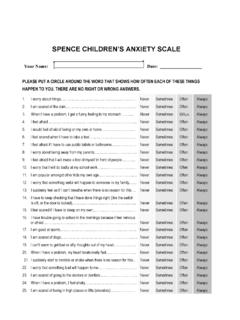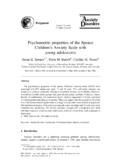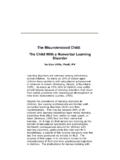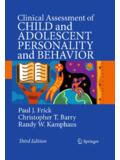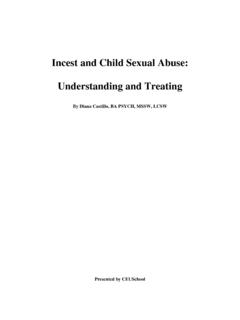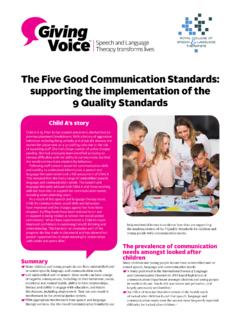Transcription of A measure of anxiety symptoms among children
1 PERGAMON Behaviour Research and Therapy 36 (1998) 545-566 BEHAVIOUR RESEARCH AND THERAPY A measure of anxiety symptoms among children Susan H. Spence Department of Psychology, University of Queensland, Brisbane, QLD 4072, Australia Received 27 June 1997; accepted 11 January 1998 Abstract The Spence children 's anxiety Scale (SCAS) is a child self-report measure designed to evaluate symptoms relating to separation anxiety , social phobia, obsessive-compulsive disorder, panic- agoraphobia, generalized anxiety and fears of physical injury. The results of confirmatory and exploratory factor analyses supported six factors consistent with the hypothesized diagnostic categories.
2 There was support also for a model in which the lst-order factors loaded significantly on a single 2nd- order factor of anxiety in general. The internal consistency of the total score and subscales was high and 6 month test-retest reliability was acceptable. The SCAS correlated strongly with a frequently used child self-report measure of anxiety . Comparisons between clinically anxious and control children showed significant differences in total SCAS scores, with subscale scores reflecting the type of presenting anxiety disorder of the clinical samples. 1998 Elsevier Science Ltd. All rights reserved. Keywords: anxiety disorders; children ; Confirmatory factor analysis; Assessment; Spence children 's anxiety Scale I.
3 Introduction anxiety disorders represent one of the most common forms of child psychopathology. Studies with community samples suggest that around 8-12% of children meet diagnostic criteria for some form of anxiety disorder that is sufficiently severe to interfere in daily functioning (Anderson et al., 1987; Costello, 1989). anxiety disorders in children may present in a variety of forms, such as separation anxiety , social phobia, generalized anxiety , panic disorder with and without agoraphobia, obsessive-compulsive disorder and specific phobias. Child anxiety disorders are associated with a range of negative consequences in terms of social, scholastic and personal adjustment (Strauss et al.)
4 , 1987; Messer and Beidel, 1994). Furthermore, there is evidence to suggest that childhood anxiety disorders are not transient phenomena for many children and that, if left untreated, may persist through adolescence and adulthood (Pfeffer et al., 1988; Keller et al., 1992). Thus, it is important that clinically anxious children are identified as early as possible and provided with appropriate intervention. 0005-7967/98/$ 1998 Elsevier Science Ltd. All rights reserved. PII: S0005-7967(98)00034-5 546 Spence / Behaviour Research and Therapy 36 (1998) 545-566 Early intervention is dependent upon the availability of psychometrically sound, valid assessment instruments to identify children with anxiety problems.
5 A structured interview represents one method of identifying anxious children , however most existing schedules are cumbersome to administer and are not practical as large scale screening instruments in schools. Child, teacher or parent questionnaires represent a more efficient method of identifying anxious children . Although there are several self-report measures of anxiety available for use with children , they suffer from two major limitations. First, most of the measures available to date are downward extensions of adult measures of anxiety and are based on the assumption that anxiety in children closely resembles the presenting features of anxiety in adults.
6 For example, two of the most commonly used self-report measures of child anxiety , namely the Revised children 's Manifest anxiety Scale (RCMAS; Reynolds and Richmond, 1978) and State-Trait anxiety Inventory for children (STAI-C; Spielberger, 1973), are both junior versions of their adult counterparts. Although evidence suggests a good deal of overlap between the presentation of anxiety problems among children and adults, clearly there are developmental differences in anxiety symptoms that need to be considered. Indeed, developmental differences in the presentation of anxiety disorders are recognized within the diagnostic criteria of DSM- IV (APA, 1994), through variation in the diagnostic criteria for specific anxiety disorders among children versus adults and through the inclusion of separation anxiety disorder as a problem specific to children .
7 Only recently, however, have researchers attempted to develop assessment instruments that are empirically derived to assess anxiety symptoms among children . For example, the Screen for Child anxiety Related Emotional Disorders (SCARED; Birmaher et al., 1997) was developed to reflect the presenting symptoms of anxiety among children . However, its development was based on the presenting features of a clinical sample and therefore the results may not be generalizable to community samples. The present study describes a scale developed specifically to assess symptoms of anxiety with children in the general population. A second limitation of most child-report measures of anxiety is the failure to examine anxiety symptoms that relate to specific anxiety disorders, such as social phobia or separation anxiety disorder.
8 Rather, questionnaires such as the RCMAS or STAI-C include items relating to anxiety in general. In practice, the clinician typically requires information about the clustering of specific patterns of anxiety problems. Such information may provide indications as to the type of situations that the child finds difficult and may guide the content of treatment. Until recently, there was a lack of measures that differentially examine the symptoms of specific types of anxiety disorder. The SCARED (Birmaher et al., 1997) mentioned above is one of the few measures to assess different forms of anxiety disorder, with factors relating to generalized anxiety disorder, separation anxiety disorder, panic disorder, social phobia and school phobia.
9 However, as noted previously, the SCARED was developed with clinically diagnosed anxious children and its validity with community samples is yet to be established. The present study examines a measure of child anxiety that includes subscales indicative of subtypes of anxiety disorder, initially developed with community samples of children . Gradually, evidence has emerged to suggest that children do indeed experience clusters of anxiety symptoms as proposed by diagnostic classification systems such as DSM-IV. Although there is considerable comorbidity across anxiety disorders in children (Anderson, 1994), Spence/Behaviour Research and Therapy 36 (1998) 545-566 547 evidence suggests that there is sufficient unique variance in subtypes of anxiety disorders to justify their retention as separate problem areas warranting individual consideration.
10 A recent study reported by Spence (1997) suggested that anxiety symptoms in children do cluster in a manner predicted by the DSM-IV (APA, 1994) classification of anxiety disorders in children , although specific types of anxiety disorder load heavily on a 2nd-order factor of anxiety in general. Support was found for clusters of anxiety symptoms indicative of social phobia, separation anxiety disorder, agoraphobia/panic disorder and obsessive compulsive disorder. There was less support for a discrete category of generalized anxiety disorder, but the evidence did suggest an additional cluster of fears relating to fears of physical injury. Birmaher et al. (1997) also reported discrete anxiety factors for the SCARED generally in keeping with DSM- IV anxiety disorder categories.



